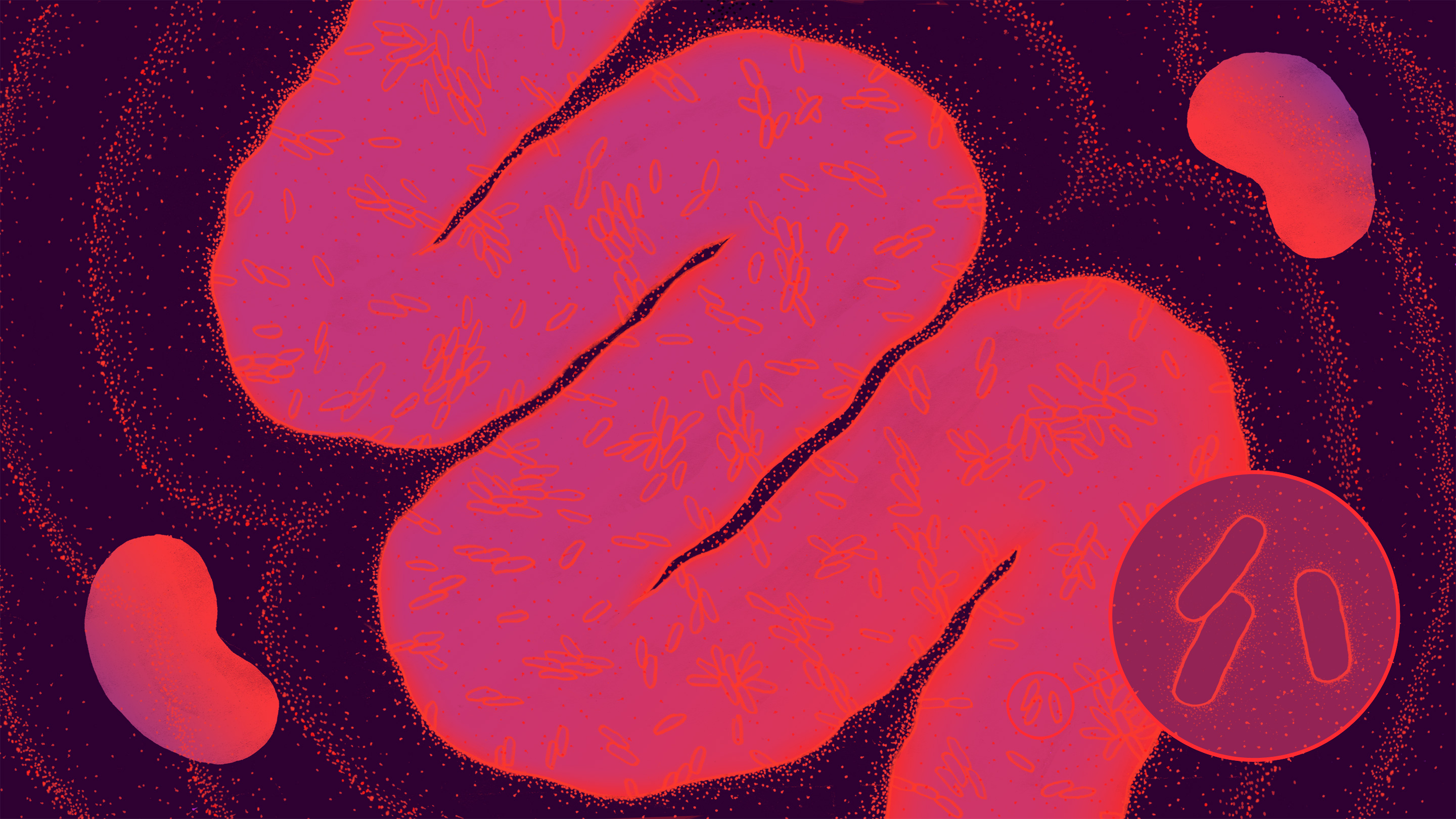How Bacteria Help Regulate Blood Pressure

In a surprising turn, researchers find that the bacteria in our guts send signals to the kidneys and blood vessels that help to balance our vital signs.
Skip Sterling for Quanta Magazine
Introduction
Some years ago, when Jennifer Pluznick was nearing the end of her training in physiology and sensory systems, she was startled to discover something in the kidneys that seemed weirdly out of place. It was a smell receptor, a protein that would have looked more at home in the nose. Given that the kidneys filter waste into urine and maintain the right salt content in the blood, it was hard to see how a smell receptor could be useful there. Yet as she delved deeper into what the smell receptor was doing, Pluznick came to a surprising conclusion: The kidney receives messages from the gut microbiome, the symbiotic bacteria that live in the intestines.
In the past few years, Pluznick, who is now an associate professor of physiology at Johns Hopkins University, and a small band of like-minded researchers have put together a picture of what the denizens of the gut are telling the kidney. They have found that these communiqués affect blood pressure, such that if the microbes are destroyed, the host suffers. The researchers have uncovered a direct, molecular-level explanation of how the microbiome conspires with the kidneys and the blood vessels to manipulate the flow of blood.
The smell receptor, called Olfr78, was an orphan at first: It had previously been noticed in the sensory tissues of the nose, but no one knew what specific scent or chemical messenger it responded to. Pluznick began by testing various chemical possibilities and eventually narrowed down the candidates to acetate and propionate. These short-chain fatty acid molecules come from the fermentation breakdown of long chains of carbohydrates — what nutritionists call dietary fiber. Humans, mice, rats and other animals cannot digest fiber, but the bacteria that live in their guts can.
As a result, more than 99 percent of the acetate and propionate that floats through the bloodstream is released by bacteria as they feed. “Any host contribution is really minimal,” Pluznick said. Bacteria are therefore the only meaningful source of what activates Olfr78 — which, further experiments showed, is involved in the regulation of blood pressure.
Our bodies must maintain a delicate balance with blood pressure, as with electricity surging through a wire, where too much means an explosion and too little means a power outage. If blood pressure is too low, an organism loses consciousness; if it’s too high, the strain on the heart and blood vessels can be deadly. Because creatures are constantly flooding their blood with nutrients and chemical signals that alter the balance, the control must be dynamic. One of the ways the body exerts this control is with a hormone called renin, which makes blood vessels narrower when the pressure needs to be kept up. Olfr78, Pluznick and her colleagues discovered, helps drive the production of renin.
How did a smell receptor inherit this job? The genes for smell receptors are present in almost every cell of the body. If in the course of evolution these chemical sensors hooked up to the machinery for manufacturing a hormone rather than to a smell neuron, and if that connection proved useful, evolution would have preserved the arrangement, even in parts of the body as far from the nose as the kidneys are.
Olfr78 wasn’t the end of the story, however. While the team was performing these experiments, they realized that another receptor called Gpr41 was getting signals from the gut microbiome as well. In a paper last year, Pluznick’s first graduate student, Niranjana Natarajan, now a postdoctoral fellow at Harvard University, revealed the role of Gpr41, which she found on the inner walls of blood vessels. Like Olfr78, Gpr41 is known to respond to acetate and propionate — but it lowers blood pressure rather than raising it. Moreover, Gpr41 starts to respond at low levels of acetate and propionate, while Olfr78 kicks in only at higher levels.
Here’s how the pieces fit together: When you — or a mouse, or any other host organism whose organs and microbes talk this way — have a meal and dietary fiber hits the gut, bacteria feed and release their fatty-acid signal. This activates Gpr41, which ratchets down the blood pressure as all the consumed nutrients flood the circulation.
If you keep eating — a slice of pie at Thanksgiving dinner, another helping of mashed potatoes — Gpr41, left to itself, might bring the pressure down to dangerous levels. “We think that is where Olfr78 comes in,” Pluznick said. That receptor, triggered as the next surge of fatty acids arrives, keeps blood pressure from bottoming out by calling for renin to constrict the blood vessels.

Today’s studies of symbiotic bacteria go far beyond simply associating them with their hosts’ health or sickness, according to Jack Gilbert, a microbiome researcher at the University of Chicago.
Courtesy of Jack Gilbert
The new understanding of how symbiotic bacteria manipulate blood pressure is emblematic of wider progress in linking the microbiome to our vital statistics and health. While vague statements about the microbiome’s effect on health have become commonplace in recent years, the field has moved beyond simply making associations, said Jack Gilbert, a microbiome researcher at the University of Chicago.
“Everybody goes on about the promise,” he said. But in fact, studies full of mechanistic details, like the ones Pluznick, her collaborators and other researchers have published, have been growing more and more numerous.
In June of last year, the National Institutes of Health convened a working group on the microbiome’s control of blood pressure. Researchers met in Maryland to thrash out what important questions still need to be answered, including what role the host’s genetic background plays — whether, for instance, the microbiome matters more for some hosts than for others.

Bina Joe, who studies physiological genomics at the University of Toledo, said that the field of microbiome research is hungry for data about specific interactions between bacteria and their hosts.
University of Toledo
“There’s a lot of excitement [about] getting more data,” said Bina Joe, a professor of physiological genomics and the director of the Center for Hypertension and Personalized Medicine at the University of Toledo. If you look at PubMed, she continued, there are more reviews of the microbiome literature than research papers. The review articles get new researchers interested — but there are still more details to hammer out.
Understanding those details is key to knowing whether transplanting a certain set of microbes into someone can reshape the recipient’s biology enough to cure a health problem, as some proponents of personalized medicine hope. One famous early study showed that giving lean mice the microbiome of an obese human made them obese too, while the microbiome of lean humans kept the mice lean. “There’s one paper that came out earlier this year … that showed that maybe this can happen with blood pressure as well,” Pluznick said, though she cautioned that the study was small and needed follow-up. But theoretically, even if swapping in new bacteria could only slightly lower the blood pressure of those with a genetic tendency toward hypertension, it could make a difference over the course of a lifetime.
“It might be something that’s easier to manipulate than your genes, or my genes. Those are much harder to change,” she said.
This article was reprinted on ScientificAmerican.com.






